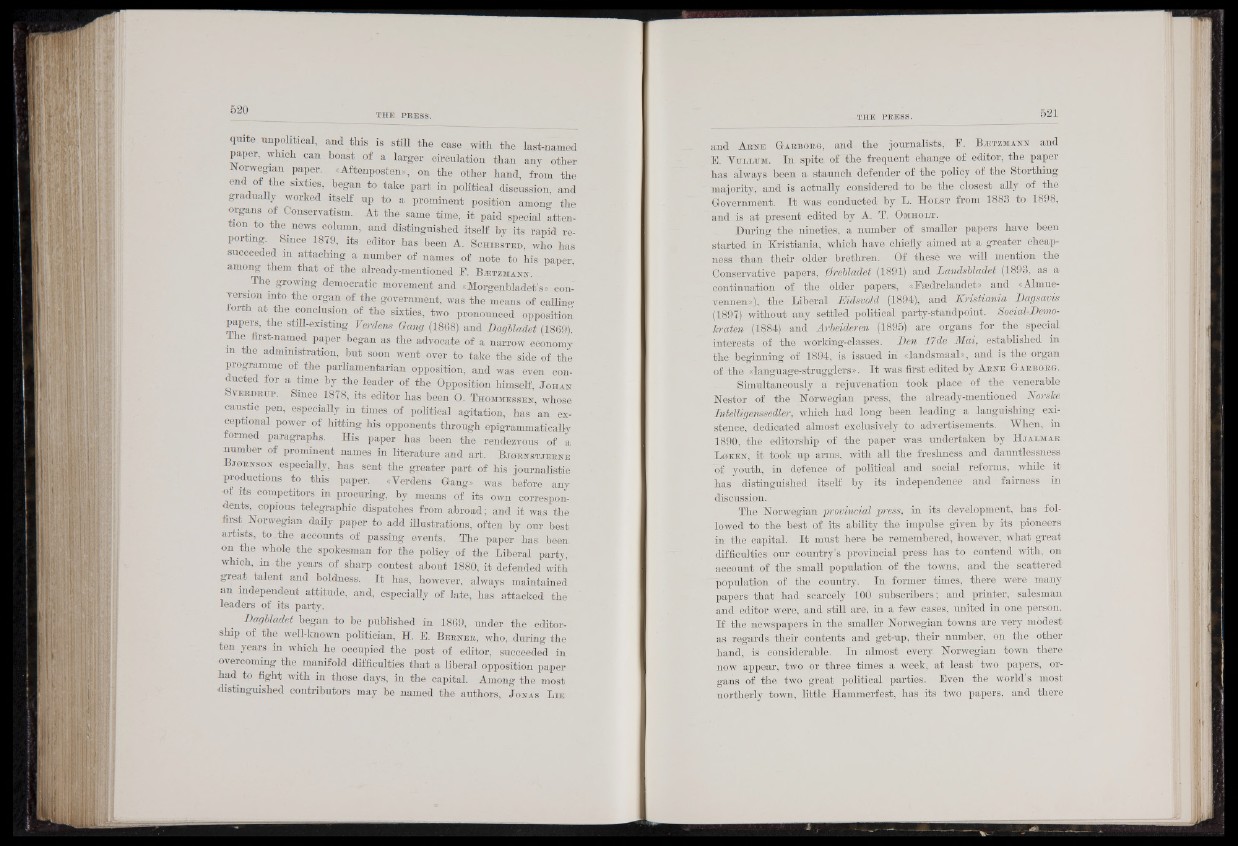
quite unpolitical, and this is still the case with the last-named
paper, which can boast of a larger circulation than any other
Norwegian paper. «Aftenposten», on the other hand, from the
end of the sixties, began to take part in political discussion, and
gradually worked itself up to a prominent position among the
organs of Conservatism. At the same time, it paid special attention
to the news column, and distinguished itself by its rapid reporting.
Since 1879, its editor has been A. S c h i b s t e b , who has
succeeded in attaching a number of names of note to his paper
among them that -of the already-mentioned F. B æ t z m a n k .
The growing democratic movement and «Morgenbladet's» con-
version into the organ of the government, was the means of calling
at the conclusion of the sixties, two pronounced opposition
papers, the still-existing Verdens Gang (1868) and BagMadet (1869).
lh e first-named paper began as the advocate of a narrow economy
m the administration, but soon went over to take the side of the
programme of the parliamentarian opposition, and was even conducted
for a time by the leader of the Opposition himself, J o h a n
S v e b d b u p . Since 1878, its editor has been O. T h o m m e s s e n , whose
caustic pen, especially in times of political agitation, has an exceptional
power of hitting his opponents through epigrammatically
formed paragraphs. His paper has been the rendezvous of a
number of prominent names in literature and art. B j h b n s t j e b n e
B j o b n s o n especially, has sent the greater part of his journalistic
productions to this paper. «Verdens Gang» was before any
of its competitors in procuring, by means of its own correspondents,
copious telegraphic dispatches from abroad; and it was the
first Norwegian daily paper to add illustrations, often by our best
artists, to . the accounts of passing events. The paper has been
on the whole the spokesman for the policy, of the Liberal party,
which, in the years of sharp contest about 1880, it defended with
great talent and boldness. I t has, however, always maintained
an independent attitude, and, especially of late, has attacked thé
leaders of its party.
BagMadet began to be published in 1869, under the editorship
of the well-known politician, H. E. B e r u b e , who, during the
ten years in which he occupied the post of editor, succeeded in
overcoming the manifold difficulties that a liberal opposition paper
had to fight with in those days, in the capital. Among the most
distinguished contributors may be named the authors, J o n a s L i e
and A b n e G a r b o b g , and the journalists, F. B j z t z m a n n and
E. V u l l t jm . In spite, of the frequent change of editor, the paper
has always been a staunch defender of the policy of the Storthing
majority, and is actually considered to be the closest ally of the
Government. I t was conducted by L. H o l s t from 1883 to 1898,
and . is at present edited by A. T. O m h o l t .
During the nineties, a number of smaller papers have been
started in Kristiania, which have chiefly aimed at a greater cheapness
than their older brethren. Of these we will mention the
Conservative papers, 0rebladet (1891) and Landsbladet (1893, as a
continuation of the older papers, «Fsedrelandet» and «Almue-
vennen»), the Liberal Eidsvold (1894), and Kristiania Bagsavis
(1897) without any settled political party-standpoint. Sodal-Bemo-
Tcraten (1884) and Arbeideren (1895) are organs for the special
interests of the working-classes. Ben 17de Mai, established in
the beginning of 1894, is issued in «landsmaal», and is the organ
of the" «language-strugglers». I t was first edited by A b n e G a e b o b g .
Simultaneously a rejuvenation took place of the venerable
Nestor of the Norwegian press, the already-mentioned Norsle
Intelligenssedler, which had long been leading a languishing existence,
dedicated almost exclusively to advertisements. When, in
1890, the editorship of the paper was undertaken by H j a l m a b
L o k e n , it took up arms, with all the freshness and dauntlessness
of youth, in defence of political and social reforms, while it
has distinguished itself by its independence and fairness in
discussion.
The Norwegian provincial press, in its development, has followed
to the best of its ability the impulse given by its pioneers
in the capital. I t must here be remembered, however, what great
difficulties our country’s provincial press has to contend with, on
account of the small population of the towns, and the scattered
population of the country. In former times, there were many
papers that had scarcely 100 subscribers; and printer, salesman
and editor were, and still are, in a few cases, united in one person.
If the newspapers in the smaller Norwegian towns are very modest
as regards their contents and get-up, their number, on the other
hand, is considerable. In almost every Norwegian town there
now appear, two or three times a week, at .least two papers, organs
of the two great political parties. Even the world’s most
northerly town, little Hammerfest, has its two papers, and there